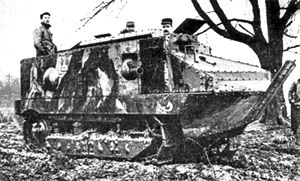
Back شنايدر سي ايه 1 Arabic Schneider CA1 BS Schneider CA1 Catalan Schneider CA1 Czech Char Schneider CA1 German Schneider CA1 Spanish Schneider CA 1 Estonian Char Schneider CA1 French Schneider CA1 Galician שניידר CA1 HE
| Schneider CA | |
|---|---|
 Schneider tank | |
| Type | Medium tank |
| Place of origin | French Third Republic |
| Service history | |
| In service | 1916–1918 (France) 1921–1936 (Spain) |
| Used by | France Kingdom of Italy Spain Fengtian Clique |
| Wars | World War I Rif War Warlord Era Spanish Civil War |
| Production history | |
| Designer | Schneider |
| Manufacturer | SOMUA |
| No. built | 400 |
| Specifications | |
| Mass | 13.6 tonnes |
| Length | 6.32 m (20 ft 9 in) |
| Width | 2.05 m (6 ft 9 in) |
| Height | 2.30 m (7 ft 7 in) |
| Crew | 6 |
| Armor | 11 + 5.5 mm (0.43 + 0.22 in) spaced |
Main armament | 75mm Blockhaus Schneider |
Secondary armament | 2×8 mm Hotchkiss M1914 machine guns |
| Engine | Schneider 4-cylinder petrol 60 hp (45 kW) |
| Power/weight | 4 hp/tonne |
| Suspension | Coil spring |
Operational range | 30/80 km |
| Maximum speed | 8.1 km/h (5.0 mph) |
The Schneider CA 1 (originally named the Schneider CA) was the first French tank, developed during the First World War.
The Schneider was inspired by the need to overcome the stalemate of trench warfare which on the Western Front prevailed during most of the Great War. It was designed specifically to open passages for the infantry through barbed wire and then to suppress German machine gun nests. After a first concept by Jacques Quellennec devised in November 1914, the type was developed from May 1915 onwards by engineer Eugène Brillié, paralleling British development of tanks the same year. Colonel Jean Baptiste Eugène Estienne in December 1915 began to urge for the formation of French armoured units, leading to an order in February 1916 for four hundred Schneider CA tanks, which were manufactured by SOMUA, a subsidiary of Schneider located in a suburb of Paris, between September 1916 and August 1918.
Like most early tanks, the Schneider was built like a simple armoured box, without compartmentalisation of the inner space. It lacked a turret, with the main armament, a short 75 mm cannon, in a sponson on the right side. By later standards it would therefore have been an assault gun instead of a tank.[1] The vehicle was considered a very imperfect design, because of a poor layout, insufficient fire-power, a cramped interior and inferior mobility due to an overhanging nose section, which had been designed to crush through the belts of barbed wire but in practice caused the tank to get stuck. Improved designs were almost immediately initiated but the production of these, the Schneider CA 2, CA 3 and CA 4, was eventually cancelled.
The Schneider CA 1 tanks were widely used in combat during the last war years. Their first action on 16 April 1917 was largely a failure, the tank units suffering heavy losses, but later engagements were more successful. In 1918 the Schneider tanks played an important role in halting the German spring offensive and breaking the German front in the French summer offensives. They were active until the end of September 1918, less than two months before the Armistice of 11 November 1918, their numbers having dropped considerably due to attrition. After the war the surviving tanks were mostly rebuilt as utility vehicles but six Schneider tanks were deployed by Spain in the Rif War in Morocco and the type saw its last action in the beginning of the Spanish Civil War.
- ^ Bryan Perrett, 1990, Tank Warfare — Combat Development in World War Two, p. 6